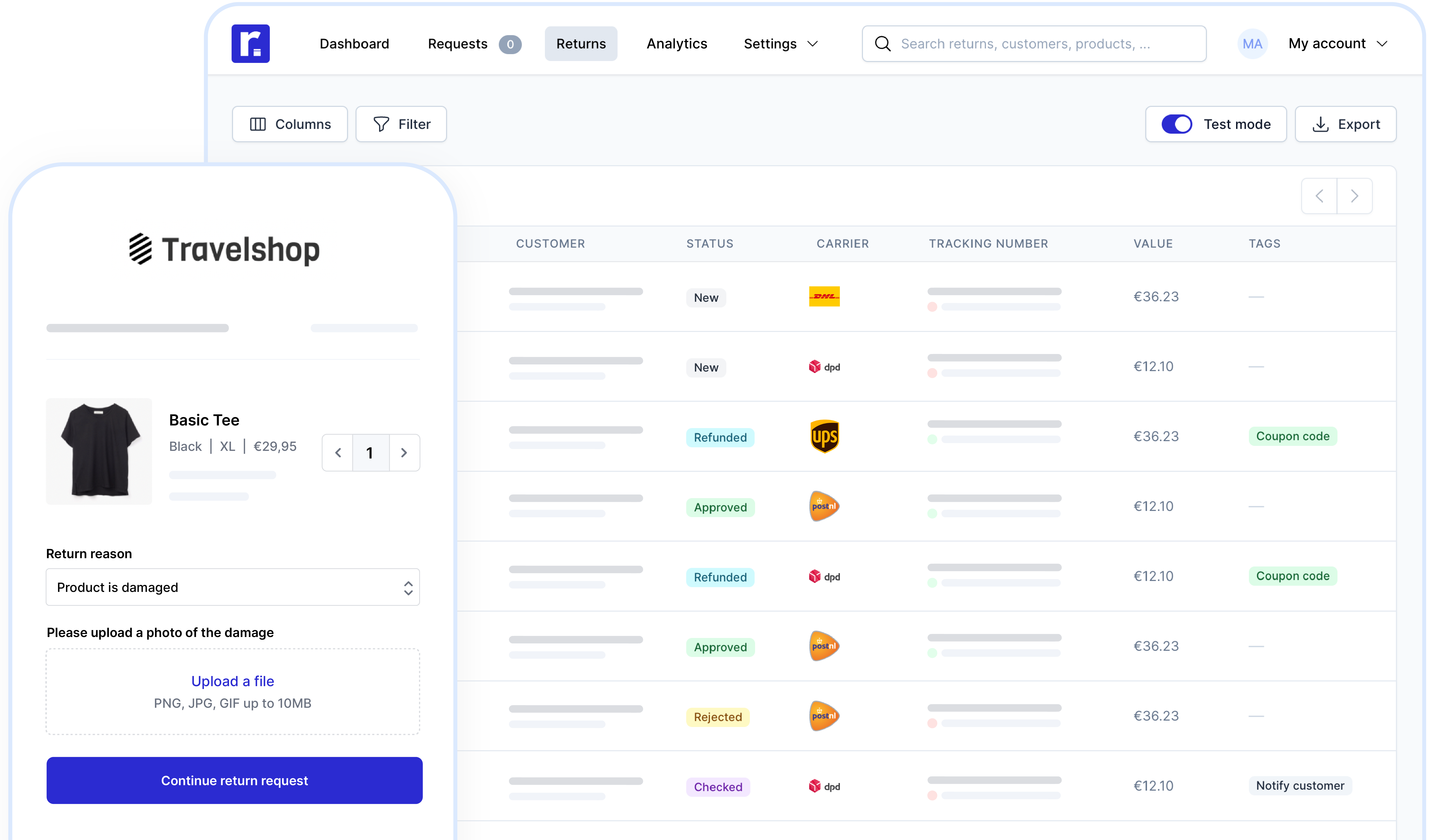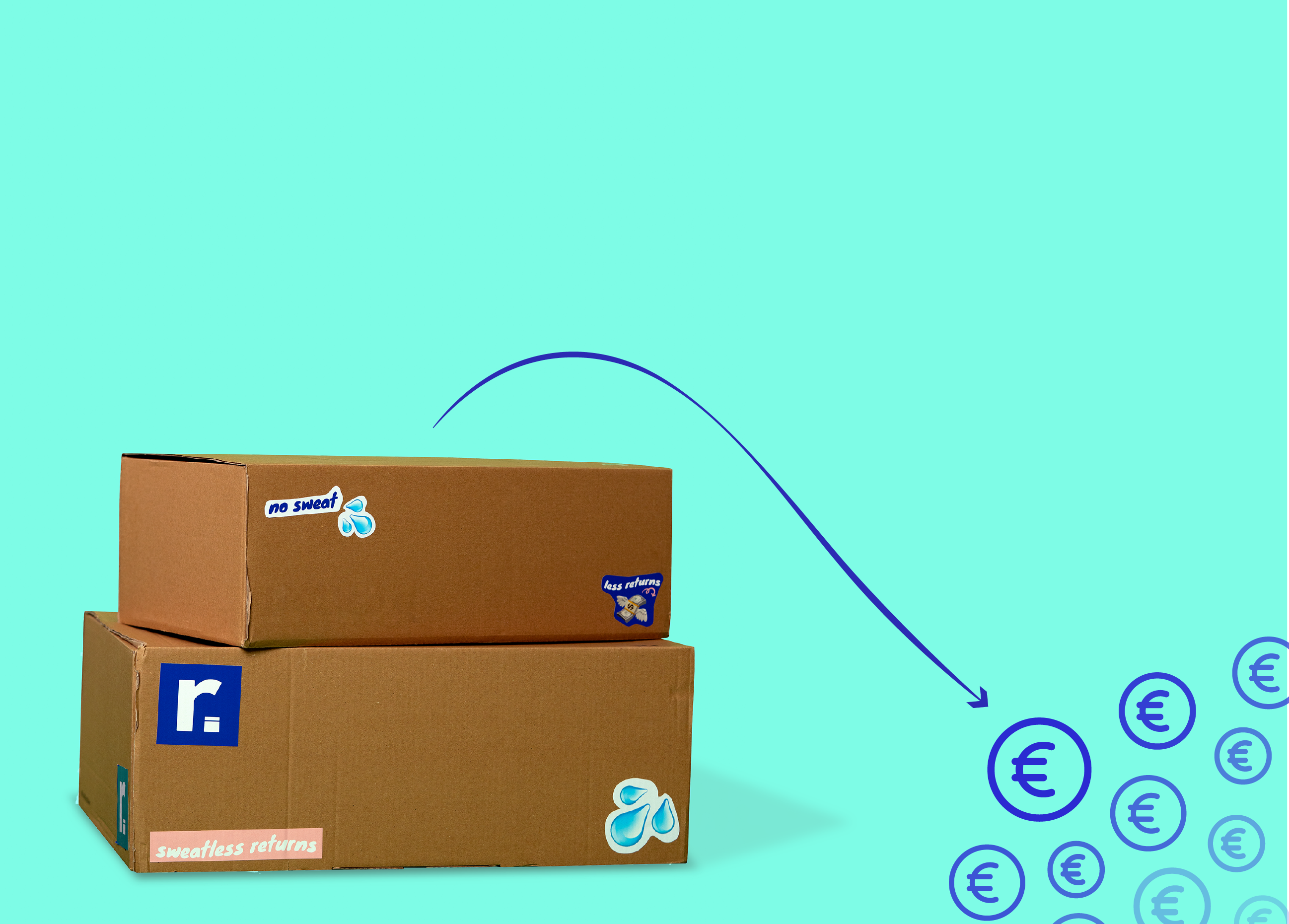
Autor
Ezra van Hassel
Date
18 December 2023
Category
Tips
Reduce return costs? How to reduce high return costs
Returns are often a big expense for online entrepreneurs: research shows that a return costs as much as 15% of the order value on average. But returns are part of e-commerce and preventing them altogether is unfortunately not possible. What you can do is apply some strategies to reduce both the number of returns and your cost per return.This way, you can reduce the cost of your returns and keep more revenue at the end of the booking year. You can read how you can go reducing your return costs in this blog.
What is a good average return rate?
Unfortunately, there is little data on the average return rate of online shops. Large retailers such as Zalando and Wehkamp often report sky-high return rates - up to 50%. However, the goal at such retailers is often purely to increase market share and brand awareness and thus differs significantly from other webshops. The main goal of smaller - and especially more sustainable - webshops is usually to increase sales in order to cover costs and make more profit. A goal that is hard to achieve with a 50% return rate.
But what then is an acceptable return rate? Do you have a return rate of less than 15%? Then you are doing very well. Are more than 20-30% of your products returned? Then it is high time to take a good look at your return process and apply some optimisations.
Prevent returns with clear return conditions
Although it seems contradictory at first glance, several studies show that a flexible and transparent returns policy can actually help increase sales without increasing returns. This is probably because before making a purchase, most online shoppers make sure they are well informed about the return policy.
A clear return policy therefore creates clarity even before the purchase about which products can be returned when and under what circumstances, thus ensuring a pleasant shopping experience for consumers. Clear return conditions and a streamlined return process are excellent strategic tools to gain consumer trust and boost conversion.
8 tips to reduce return costs:
1. Improve your returns process
The returns process is often a headache for online retailers: paper return forms, lack of overview and constant customer service queries. But it can be done differently! With an optimised returns process, you can save a lot of time and money. The first step is a digital returns form where customers can register their returns themselves. This way, you create a digital gatekeeper that automatically assesses every return based on the information entered.
Unlawful returns are thus stopped fully automatically, allowing you to save not only on staff costs, but also on shipping costs. Moreover, you can use different return options, for instance offering free returns only in certain cases.
2. Save on shipping costs
As an online shop, you usually send and return large quantities of parcels. With the right transport company and its rates, you can save a lot of money. Negotiate the rates for returns with several carriers; more and more transport companies have separate rates for returns.
Tip: If you don't want to negotiate yourself, you can also use Returnless' advantageous rates.
Not only can you save money via hard costs, you can also offer different methods for returns - for example, allowing ordered items to be returned to a physical shop. This way, your employees can check returns directly, allowing the returned items to reenter your distribution network quickly. You can also save money with a pick-up service sometimes and also improve the customer experience.
3. Communicate with the customer
Many customer service enquiries come from the customer's need to be informed about the status of the return. It can be exciting for the customer to return a product and then wait for a refund. Has the return arrived at the warehouse yet? Is the refund already on its way? It is a terrible waste when your customer service department has to spend time dealing with such queries. Not only does this cost money, such questions also get on your employees' nerves.
With a digital and optimised returns process, you can communicate proactively with your customers and they always know where they stand regarding their returns. For example, they can check the status of their returns themselves in the returns portal or follow the package live via the track & trace code.
4. Simplify the returns process
It seems counterproductive, but many different studies show the same thing: a flexible and clear return policy can increase sales without increasing the number of returns. So a simple and smooth return process for your consumers is an easy way to sell more.
Let your customers register their returns independently via a digital return form. This allows them to instantly download a return label or view alternatives to standard returns. Such an alternative option could be uploading a photo if the product is damaged, or opting for a credit instead of a refund so they can immediately order the product in a different size or colour. This will not only make the return process easier for your employees (and save you time and staff costs), but your customers will also enjoy an easier return process, making them more likely to return to your webshop.
5. Clarify the return policy
As mentioned earlier, it is important to clearly state your return conditions on your website. Use as much jargon as possible and define the conditions as clearly as possible. This can be done, for instance, by using Returnless' return rules. This allows you to set specific conditions in the digital return form. If one of these conditions is met, the defined follow-up action is carried out fully automatically. You can also use automated follow-up questions to find out exactly why an item is returned and, for example, automatically reject returns whose return period has already expired. This not only saves return costs, but also a lot of administrative hassle.
6. Free returns
Free returns have long served as a reliable strategy to increase sales. Free shipping and returns are therefore a deliberately deployed marketing tool for many online shops, and it is often thought that without them you cannot compete with big retailers like Zalando and Amazon. But free returns are really low-hanging fruit in saving costs on your returns. After all, you don't necessarily need to offer free returns to all your customers. Especially since shoppers these days are getting more and more used to the idea of paying for returns again.
If your customers submit their returns digitally, you can apply rules to select which returns you want to offer for free and which returns your customers have to pay for themselves - for example, when the purchase amount of the returned product is too low to be profitable.
7. Return period longer than 14 days
A longer return period is a measure you might not immediately think of. However, research has shown that a longer return period can help reduce returns overall. This can also be concluded from the fact that many large online retailers such as Coolblue, Zalando and IKEA maintain a longer return period than the legal minimum of 14 days.
Why exactly this is the case is not entirely clear. What we do know is that most returns occur in the first few days after receipt. And even though there is probably nothing you can do to change that, a longer return period does allow consumers to think longer and so they may be more inclined to forget about the return or abandon it altogether.
8. Analyse your return data
Many returns occur because expectations of online purchases differ from the actual product received. With detailed return data, you can easily analyse why which products are (often) returned. You can then use this information to optimise your webshop and give consumers the most accurate picture of your products. Provide good product descriptions and clear photos, size charts if you sell fashion products and paint a clear picture of the product by, for example, also mentioning negative points. This way, you can prevent 'wrong' orders and again reduce returns.
Reduce your costs with Returnless
Returns are inextricably linked to e-commerce and completely, unfortunately, we can never avoid them. However, there are simple strategies to reduce both the number of returns and the cost per return. A returns solution such as Returnless gives you all the tools to easily deploy these strategies. With Returnless, you can easily create a digital return form in the same style as your webshop, automatically create return labels, or set smart return rules to catch unnecessary returns in time, for example. This way, you can not only save costs, but also increase customer satisfaction.
Want to try it out yourself? Create a free test account now or contact us for a no-obligation demo of our product.
get started for free.
Play around and test out all features for free. Or schedule a demo with one of our colleagues if you'd like more info first.

